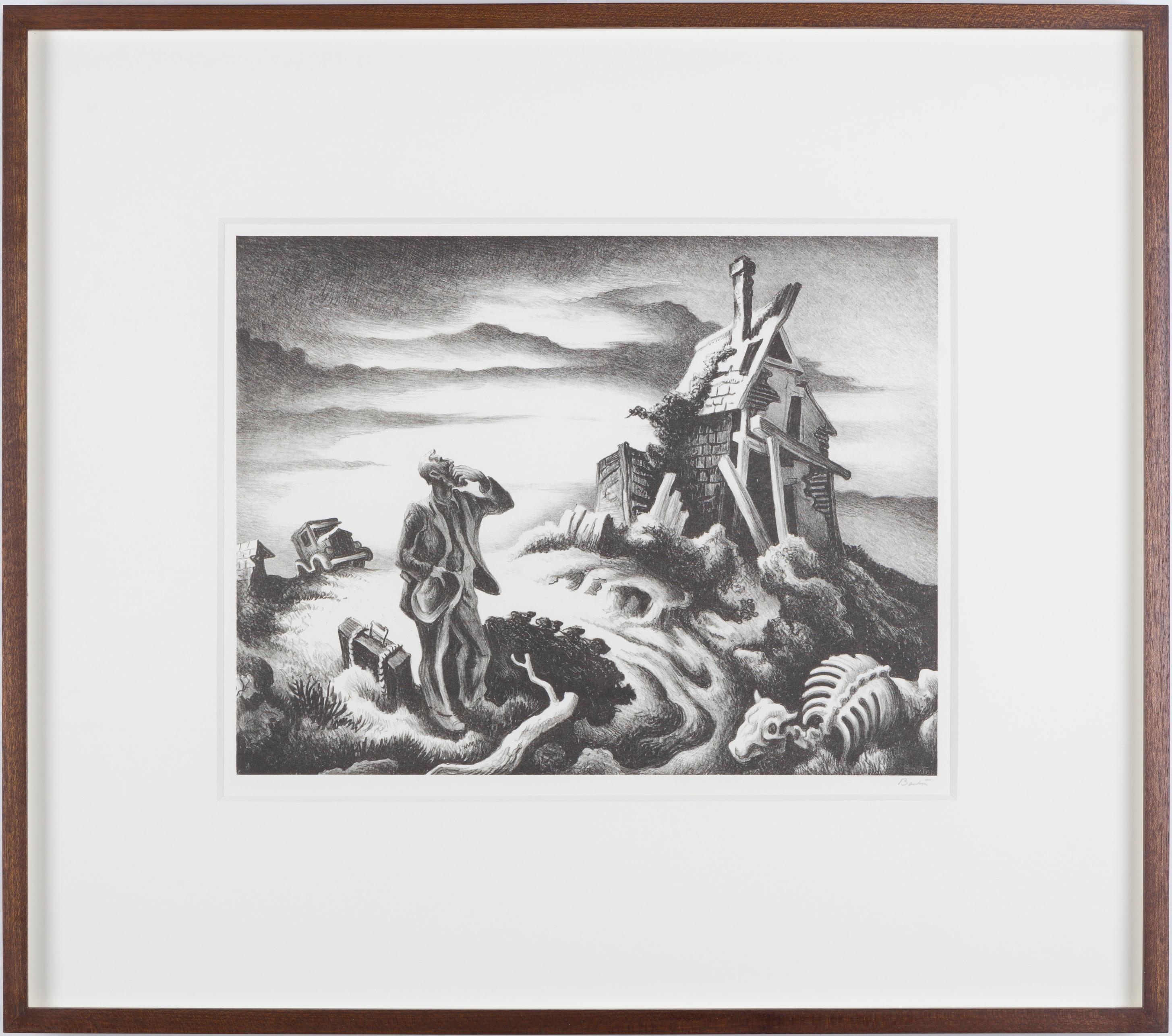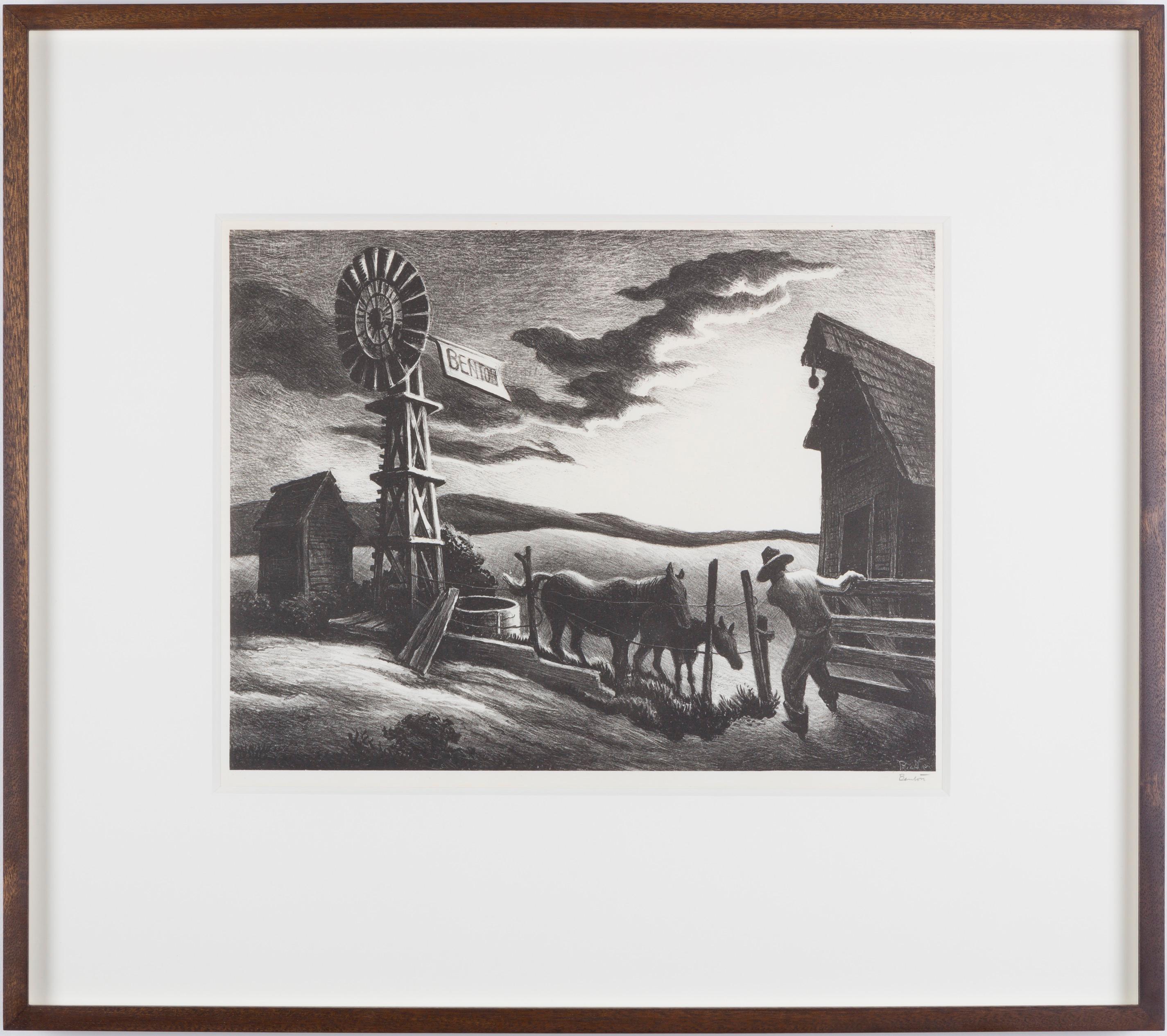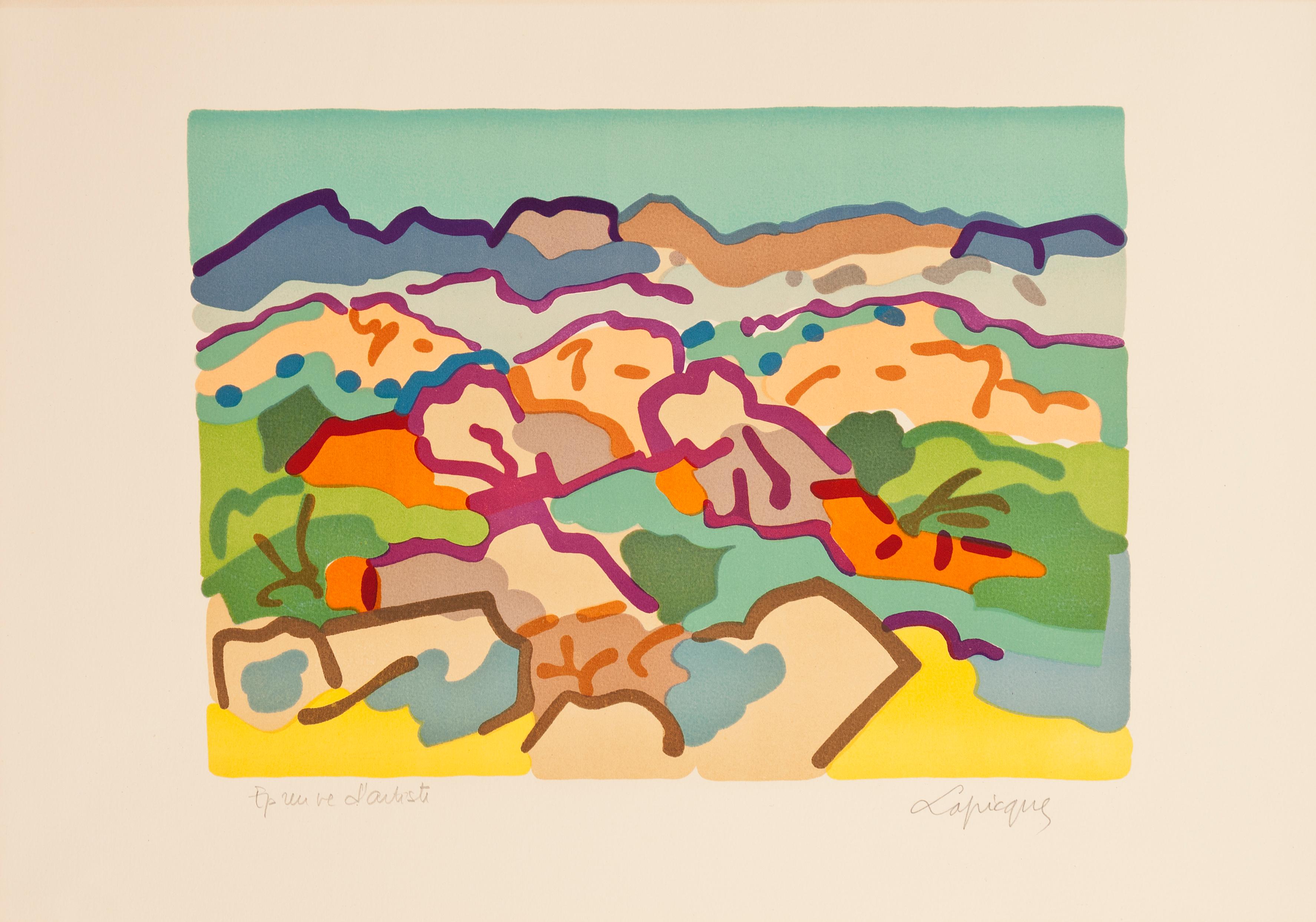Items Similar to 'Trees in Ranchitos II' — 1970s Taos Modernism
Want more images or videos?
Request additional images or videos from the seller
1 of 6
Andrew Dasburg'Trees in Ranchitos II' — 1970s Taos Modernism1975
1975
About the Item
Andrew Dasburg, 'Trees in Ranchitos II', two-color lithograph, 1975, edition 20. Signed 'A. D.' in pencil. Annotated 'Trial Proof' in pencil, verso. A superb impression, in dark taupe ink on wheaten-inked background, printed on heavy Natural Nacre fibrous Japan paper, the full sheet with margins (2 3/4 to 3 3/8 inches), in excellent condition. Scarce.
Printed at the renowned Tamarind Institute Fine Art Lithography Workshop by collaborating printers John Sommers and Robert Blanchard, with the Tamarind Institute bell blind stamp, beneath the image, lower left.
Image size 16 1/2 x 23 3/8 inches (419 x 594 mm); sheet size 22 1/2 x 29 inches (572 x 737 mm). Archivally matted to museum standards, unframed.
ABOUT THE ARTIST
Andrew Dasburg (1887-1979) was born in France and lived in Germany before immigrating to New York City with his family at the age of five. Dasburg showed artistic aptitude from an early age and, as a young man, was awarded a scholarship to the Art Students League in New York.
In 1909 Dasburg returned to Paris to work with fellow artists Morgan Russell, Arthur Lee, and Jo Davidson. He was introduced to the Parisian avant-garde, including Henri Matisse, Pablo Picasso, and author Gertrude Stein. He found resonance with the early development of cubism and the work of Cézanne, which led him to become a pioneer of American modernism. On a short trip to England during this period, Dasburg married sculptor Grace Mott Johnson.
Dasburg and Johnson returned to the United States and became a part of the artist community in Woodstock, New York, frequently returning to New York City for exhibitions. In 1913 Dasburg showed at the First International Exhibition of Modern Art, also known as the 'Armory Show.' Dasburg’s cubist paintings gained immediate attention, and in subsequent years Dasburg was asked to show at Alfred Stieglitz’s renowned gallery ‘291’. During this period, Dasburg also pursued his interest in Synchromism, a movement that emphasized the psychological effects of color and its relationship to music through non-objective cubist abstraction.
Dasburg first went to New Mexico in the early 1900s at the urging of his friends Mabel Dodge and Maurice Sterne, finally settling in Taos in 1933. The striking mountains and valleys of Taos provided the inspiration that was to dominate his work for more than fifty years. The Taos Series, which Dasburg made at Tamarind Institute in 1974-75 at age 87, were his first published lithographs.
Dasburg received several important awards for his work, including the second prize at the Pan American Exhibition, Los Angeles, 1925; third prize at the 26th International of Painting, Carnegie Institute, 1927; and a Guggenheim Fellowship in 1932.
Dasburg’s work is held in numerous museum collections, including the Albuquerque Museum, Barnes Foundation, Dallas Museum of Art, Denver Art Museum, Harwood Museum of Art, Los Angeles County Museum of Art, Metropolitan Museum of Art, Modern Art Museum of Fort Worth, Philadelphia Museum of Art, San Francisco Museum of Modern Art, Santa Barbara Museum of Art, Smithsonian American Art Museum, and the Whitney Museum of American Art.
- Creator:Andrew Dasburg (1887 - 1979, American)
- Creation Year:1975
- Dimensions:Height: 16.5 in (41.91 cm)Width: 23.38 in (59.39 cm)
- Medium:
- Movement & Style:
- Period:
- Condition:
- Gallery Location:Myrtle Beach, SC
- Reference Number:
About the Seller
5.0
Recognized Seller
These prestigious sellers are industry leaders and represent the highest echelon for item quality and design.
Platinum Seller
These expertly vetted sellers are 1stDibs' most experienced sellers and are rated highest by our customers.
Established in 1995
1stDibs seller since 2016
254 sales on 1stDibs
Typical response time: 1 hour
Associations
International Fine Print Dealers Association
- ShippingRetrieving quote...Ships From: Myrtle Beach, SC
- Return PolicyA return for this item may be initiated within 7 days of delivery.
More From This SellerView All
- 'Navajo Horse Race' — 1940s Southwest RegionalismBy Ira MoskowitzLocated in Myrtle Beach, SCIra Moskowitz, 'Navajo Horse Race', lithograph, 1946, edition 30, Czestochowski 204. Signed and titled in pencil. Signed and dated in the stone, lower le...Category
1940s American Modern Landscape Prints
MaterialsLithograph
- 'Navajo Trading Post' — 1940s Southwest RegionalismBy Ira MoskowitzLocated in Myrtle Beach, SCIra Moskowitz, 'Navajo Trading Post', lithograph, 1946, edition 30, Czestochowski 161. Signed and dated in the stone, lower left. A fine, richly-inked impression, on cream wove paper, with full margins (1 1/2 to 3 1/8 inches). Pale mat line, otherwise in excellent condition. Matted to museum standards, unframed. Image size 11 11/16 x 15 1/2 inches (297 x 395 mm); sheet size 16 5/16 x 191/8 inches (414 x 486 mm). ABOUT THE ARTIST Ira Moskowitz was born in Galicia, Poland, in 1912, emigrating with his family to New York in 1927. He enrolled at the Art Student's League and studied there from 1928-31. In 1935, Moskowitz traveled to Paris and then lived until 1937 in what is now Israel. He returned to the United States in 1938 to marry artist Anna Barry in New York. The couple soon visited Taos and Santa Fe in New Mexico, returning for extended periods until 1944, when they moved there permanently, staying until 1949. During this especially productive New Mexico period, Moskowitz received a Guggenheim fellowship. His work was inspired by the New Mexico landscape and the state’s three cultures (American Southwest, Native American, and Mexican). He focused on Pueblo and Navajo life, producing an extensive oeuvre of authentic American Indian imagery. He and Anna also visited and sketched across the border in Old Mexico. While in the Southwest, Moskowitz flourished as a printmaker while continuing to produce oils and watercolors. Over 100 of Moskowitz’s works depicting Native American ceremonies were used to illustrate the book American Indian Ceremonial Dances by John Collier, Crown Publishers, New York, 1972. After leaving the Southwest, printmaking remained an essential medium for the artist while his focus changed to subject matter celebrating Judaic religious life and customs. These works were well received early on, and Moskowitz was content to stay with them the rest of his life. From 1963 until 1966, Moskowitz lived in Paris, returning to New York City in 1967, where he made his permanent home until he died in 2001. Shortly before his death, Zaplin-Lampert Gallery of Santa Fe staged an exhibition of the artist's works, December 2000 - January 2001. Other one-person shows included the 8th Street Playhouse, New York, 1934; Houston Museum, 1941; and the San Antonio Museum, 1941. The artist’s work was included in exhibitions at the Art Students League, Art Institute of Chicago, Philadelphia Print Club, College Art Association (promotes excellence in scholarship and teaching), and the International Exhibition of Graphic Arts (shown at MOMA, 1955). Moskowitz’s lithographs of American Indian...Category
1940s American Modern Landscape Prints
MaterialsLithograph
- 'Navajo Courtship Dance' — 1940s Southwest RegionalismBy Ira MoskowitzLocated in Myrtle Beach, SCIra Moskowitz, 'Navajo Courtship Dance (Squaw Dance)', lithograph, 1946, edition 30, Czestochowski 161. Signed and titled in pencil. Signed and dated in the stone, lower left. A fine, richly-inked impression, on cream wove paper; the full sheet with margins (7/16 to 2 3/4 inches). Pale mat line, otherwise in excellent condition. Matted to museum standards, unframed. Image size 11 13/16 x 14 13/16 inches (300 x 376 mm); sheet size 13 1/16 x 20 1/8 inches (332 x 511 mm). ABOUT THE ARTIST Ira Moskowitz was born in Galicia, Poland, in 1912, emigrating with his family to New York in 1927. He enrolled at the Art Student's League and studied there from 1928-31. In 1935, Moskowitz traveled to Paris and then lived until 1937 in what is now Israel. He returned to the United States in 1938 to marry artist Anna Barry in New York. The couple soon visited Taos and Santa Fe in New Mexico, returning for extended periods until 1944, when they moved there permanently, staying until 1949. During this especially productive New Mexico period, Moskowitz received a Guggenheim fellowship. His work was inspired by the New Mexico landscape and the state’s three cultures (American Southwest, Native American, and Mexican). He focused on Pueblo and Navajo life, producing an extensive oeuvre of authentic American Indian imagery. He and Anna also visited and sketched across the border in Old Mexico. While in the Southwest, Moskowitz flourished as a printmaker while continuing to produce oils and watercolors. Over 100 of Moskowitz’s works depicting Native American ceremonies were used to illustrate the book American Indian Ceremonial Dances by John Collier, Crown Publishers, New York, 1972. After leaving the Southwest, printmaking remained an essential medium for the artist while his focus changed to subject matter celebrating Judaic religious life and customs. These works were well received early on, and Moskowitz was content to stay with them the rest of his life. From 1963 until 1966, Moskowitz lived in Paris, returning to New York City in 1967, where he made his permanent home until he died in 2001. Shortly before his death, Zaplin-Lampert Gallery of Santa Fe staged an exhibition of the artist's works, December 2000 - January 2001. Other one-person shows included the 8th Street Playhouse, New York, 1934; Houston Museum, 1941; and the San Antonio Museum, 1941. The artist’s work was included in exhibitions at the Art Students League, Art Institute of Chicago, Philadelphia Print Club, College Art Association (promotes excellence in scholarship and teaching), and the International Exhibition of Graphic Arts (shown at MOMA, 1955). Moskowitz’s lithographs of...Category
1940s American Modern Landscape Prints
MaterialsLithograph
- 'Navajo Medicine Ceremony of the Night Chant' — 1940s Southwest RegionalismBy Ira MoskowitzLocated in Myrtle Beach, SCIra Moskowitz, 'The Three Gods of Healing (Navajo Medicine Ceremony of the Night Chant)', lithograph, 1945, edition 30, Czestochowski 148. Signed and titled in pencil. Signed and dated in the stone, lower right. A fine, richly-inked impression, on cream wove paper, with full margins (2 1/4 to 2 3/4 inches), in excellent condition. Matted to museum standards, unframed. Image size 12 1/4 x 15 13/16 inches (311 x 402 mm); sheet size 17 1/8 x 20 7/8 inches (435 x 530 mm). ABOUT THIS WORK The nine-night ceremony known as the Night Chant or Nightway is believed to date from around 1000 B.C.E. when it was first performed by the Indians who lived in Canyon de Chelly (now eastern Arizona). It is considered the most sacred of all Navajo ceremonies and one of the most difficult and demanding to learn, as it encompasses hundreds of songs, dozens of prayers, and several highly complex sand paintings. And yet the demand for Night Chants is so great that as many as fifty such ceremonies might be held during a single winter season, which lasts eighteen to twenty weeks. The Night Chant is designed both to cure people who are ill and to restore the order and balance of human and non-human relationships within the Navajo universe. Led by a trained medicine man who has served a long apprenticeship and learned the intricate and detailed practices that are essential to the chant, the ceremony itself is capable of scaring off sickness and ugliness through techniques that shock or arouse. Once the disorder has been removed, order and balance are restored through song, prayer, sand painting, and other aspects of the ceremony. The medicine men who supervise the Night Chant ensure that everything—each dot and line in every sand painting, each verse in every song, each feather on each mask is arranged precisely, or it will not bring about the desired result. There are probably as many active Night Chant medicine men today as at any time in Navajo history due to the general increase in the Navajo population, the popularity of the ceremony, and the central role it plays in Navajo life and health. ABOUT THE ARTIST Ira Moskowitz was born in Galicia, Poland, in 1912, emigrating with his family to New York in 1927. He enrolled at the Art Student's League and studied there from 1928-31. In 1935, Moskowitz traveled to Paris and then lived until 1937 in what is now Israel. He returned to the United States in 1938 to marry artist Anna Barry in New York. The couple soon visited Taos and Santa Fe in New Mexico, returning for extended periods until 1944, when they moved there permanently, staying until 1949. During this especially productive New Mexico period, Moskowitz received a Guggenheim fellowship. His work was inspired by the New Mexico landscape and the state’s three cultures (American Southwest, Native American, and Mexican). He focused on Pueblo and Navajo life, producing an extensive oeuvre of authentic American Indian imagery. He and Anna also visited and sketched across the border in Old Mexico. While in the Southwest, Moskowitz flourished as a printmaker while continuing to produce oils and watercolors. Over 100 of Moskowitz’s works depicting Native American ceremonies were used to illustrate the book American Indian Ceremonial Dances by John Collier, Crown Publishers, New York, 1972. After leaving the Southwest, printmaking remained an essential medium for the artist while his focus changed to subject matter celebrating Judaic religious life and customs. These works were well received early on, and Moskowitz was content to stay with them the rest of his life. From 1963 until 1966, Moskowitz lived in Paris, returning to New York City in 1967, where he made his permanent home until he died in 2001. Shortly before his death, Zaplin-Lampert Gallery of Santa Fe staged an exhibition of the artist's works, December 2000 - January 2001. Other one-person shows included the 8th Street Playhouse, New York, 1934; Houston Museum, 1941; and the San Antonio Museum, 1941. The artist’s work was included in exhibitions at the Art Students League, Art Institute of Chicago, Philadelphia Print Club, College Art Association (promotes excellence in scholarship and teaching), and the International Exhibition of Graphic Arts (shown at MOMA, 1955). Moskowitz’s lithographs of...Category
1940s American Modern Landscape Prints
MaterialsLithograph
- 'Pulitzer Fountain, Evening" — 1940s American Modernism, New York CityBy Ellison HooverLocated in Myrtle Beach, SCEllison Hoover, 'Pulitzer Fountain, Evening', lithograph, circa 1940, edition c. 40. Signed in pencil. A fine, atmospheric impression, on cream wove paper; the full sheet with margin...Category
Mid-20th Century American Modern Landscape Prints
MaterialsLithograph
- 'Partners' — Mid-Century Modernist RegionalismBy Dale NicholsLocated in Myrtle Beach, SCDale Nichols, 'Partners', lithograph, edition 250, 1950. Signed in pencil. A fine, richly-inked impression, on cream wove paper; the full sheet with margins (7/8 to 1 5/8 inches); tw...Category
1950s American Modern Landscape Prints
MaterialsLithograph
You May Also Like
- Prodigal SonBy Thomas Hart BentonLocated in London, GBA fine impression with full margins published by Associated American Artists with their information label present - pictured in Art and Popular Religion in Evangelical America, 1815-...Category
1930s American Modern Landscape Prints
MaterialsLithograph
- Nebraska EveningBy Thomas Hart BentonLocated in London, GBA fine impression with good margins published by Associated American Artists.Category
1940s American Modern Landscape Prints
MaterialsLithograph
- Campagne Grecque (Greek Country) by Charles Lapicque - signed color lithographBy Charles LapicqueLocated in New York, NYThis beautiful original lithograph depicting a Greek landscape by Charles Lapicque was printed in Paris at the Atelier Mourlot in 1964. The artist produced some of his first landscap...Category
1960s Modern Landscape Prints
MaterialsLithograph
- Thin-lipped Armourer I: black drawing based on Auden poetry, Yorkshire landscapeBy Henry MooreLocated in New York, NYThis darkly-shaded portrait of two figures is one of a series of 18 lithographs drawn by the artist for the Auden Poems/Moore Lithographs 1974 book and portfolio. This work is from a...Category
Late 20th Century Modern Abstract Prints
MaterialsLithograph
- Blue Rolling Waves off Sidney, Seascape Diptych Cyanotype, Australian Coast SurfBy Kind of CyanLocated in Barcelona, ESThis is an exclusive handprinted limited edition cyanotype. "Rolling Waves off Sidney" is a gorgeous original cyanotype diptych showing energetic waves embracing the Australian coas...Category
2010s Modern Landscape Drawings and Watercolors
MaterialsPhotogram, Photographic Film, Monotype, Lithograph, Dye Transfer, Color,...
- Sketches of Auden: black drawing based on Auden poetry and Yorkshire landscapeBy Henry MooreLocated in New York, NYThis black and white portrait drawing is one of a series of 18 lithographs drawn by the artist for the Auden Poems/Moore Lithographs 1974 book and portfolio. This work is from an edition of 25 printed on vellum aside from the portfolio (edition of 75) and the book. Signed by the artist and numbered 8/25 lower right in pencil. This print features a pair of sketches...Category
Late 20th Century Modern Abstract Prints
MaterialsLithograph
Recently Viewed
View AllMore Ways To Browse
Vintage Modernism
3d Robert
Picasso 1933
Vintage Barnes
French Lithograph Tree
1900s Ink
Retro Sheet Music Art
Bells Made In England
Picasso Trip To Paris
Barnes Foundation
Tamarind Prints
Pablo Picasso Foundation
Matisse Tree
Tamarind Lithograph
Vintage Dodge
Artist 1970s Mountains Landscape
Paintings By Blanchard
1900s Mexico





